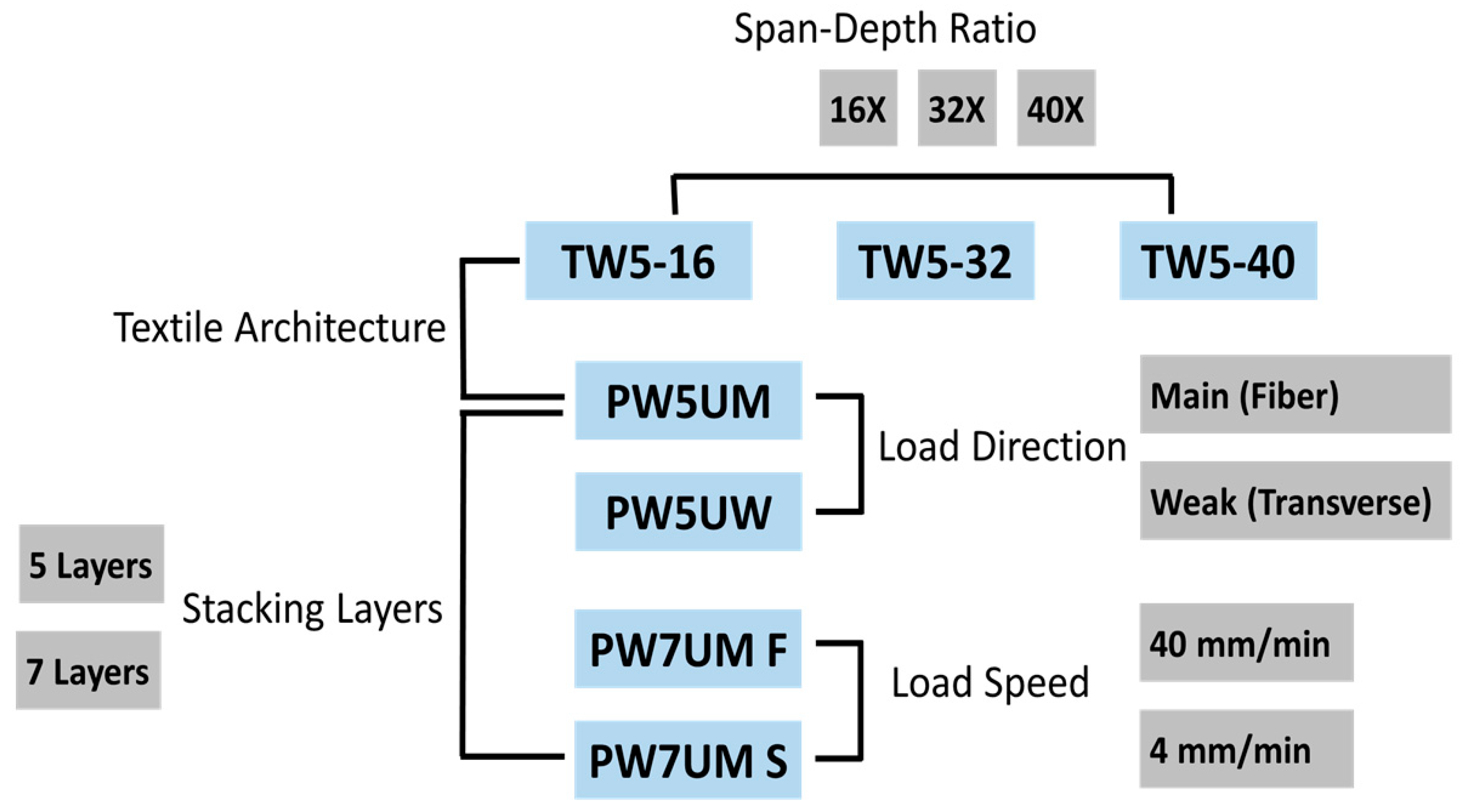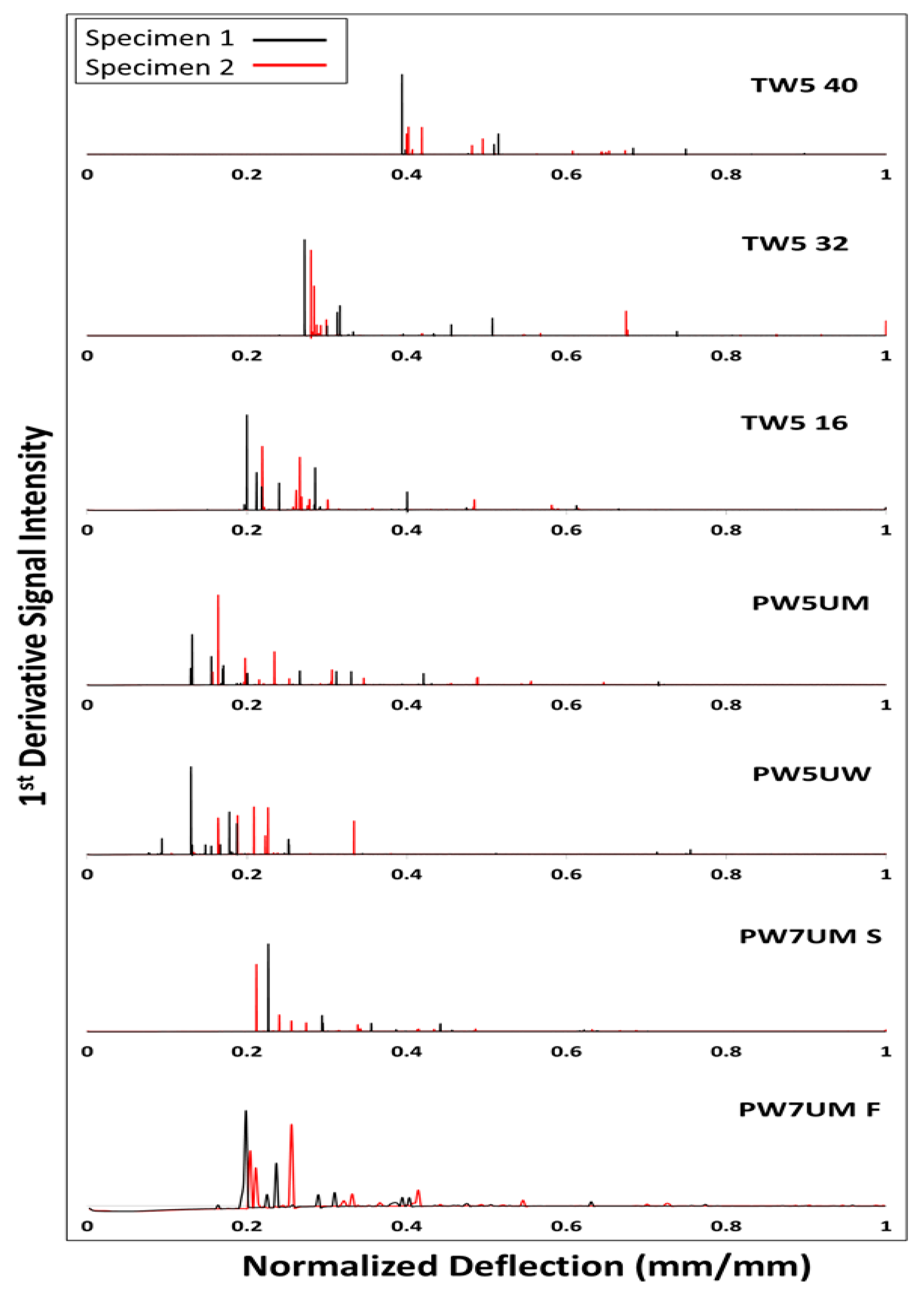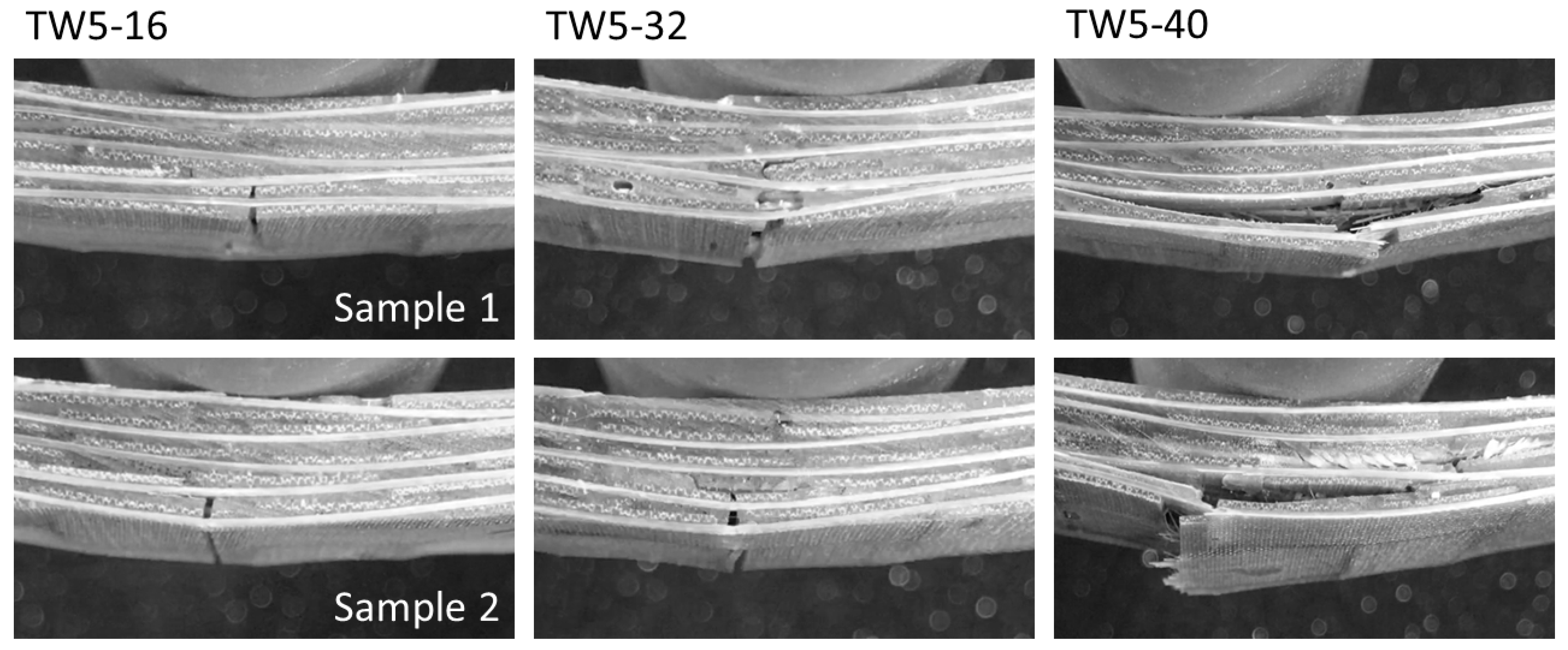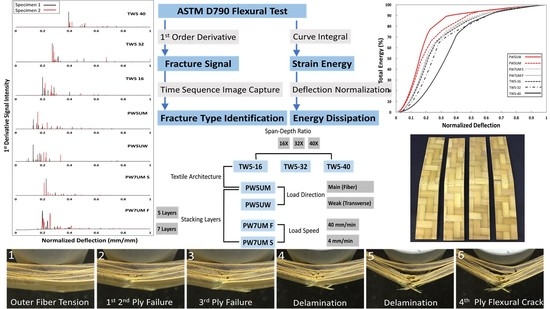Fracture Characteristics and Energy Dissipation of Textile Bamboo Fiber Reinforced Polymer
Abstract
:1. Introduction
2. Materials & Methods
2.1. Manufacturing of Bamboo Strips and Composite Molding
2.2. Quasit-Static Flexural Test
2.3. 1st Derivative Fracture Signal
2.4. Fracture Image Capturing
3. Results
3.1. Flexural Properties of BTRPs
3.2. 1st Derivative Fracture Signal
3.3. Energy Dissipation Curve
4. Discussion
4.1. Effects of Load Direction
4.2. Effects of Preform Structure
4.3. Effects of Preform Layers
4.4. Effects of Span-to-Depth Ratio
5. Conclusions
Author Contributions
Funding
Institutional Review Board Statement
Informed Consent Statement
Data Availability Statement
Conflicts of Interest
References
- Arrakhiz, F.Z.; Malha, M.; Bouhfid, R.; Benmoussa, K.; Qaiss, A. Tensile, flexural and torsional properties of chemically treated alfa, coir and bagasse reinforced polypropylene. Compos. Part B Eng. 2013, 47, 35–41. [Google Scholar] [CrossRef]
- Khalil, H.A.; Bhat, I.; Jawaid, M.; Zaidon, A.; Hermawan, D.; Hadi, Y. Bamboo fibre reinforced biocomposites: A review. Mater. Des. 2012, 42, 353–368. [Google Scholar] [CrossRef]
- Zhang, K.; Wang, F.; Liang, W.; Wang, Z.; Duan, Z.; Yang, B. Thermal and Mechanical Properties of Bamboo Fiber Reinforced Epoxy Composites. Polymers 2018, 10, 608. [Google Scholar] [CrossRef] [Green Version]
- Xiao, B.; Wang, W.; Zhang, X.; Long, G.; Fan, J.; Chen, H.; Deng, L. A novel fractal solution for permeability and Kozeny-Carman constant of fibrous porous media made up of solid particles and porous fibers. Powder Technol. 2019, 349, 92–98. [Google Scholar] [CrossRef]
- Xiao, B.; Huang, Q.; Chen, H.; Chen, X.; Long, G. A Fractal Model for Capillary Flow through a Single Tortuous Capillary with Roughened Surfaces in Fibrous Porous Media. Fractals 2021. [Google Scholar] [CrossRef]
- Boisse, P.; Colmars, J.; Hamila, N.; Naouar, N.; Steer, Q. Bending and wrinkling of composite fiber preforms and prepregs. A review and new developments in the draping simulations. Compos. Part B Eng. 2018, 141, 234–249. [Google Scholar] [CrossRef]
- Friedrich, K.M.; Almajid, A.A. Manufacturing Aspects of Advanced Polymer Composites for Automotive Applications. Appl. Compos. Mater. 2012, 20, 107–128. [Google Scholar] [CrossRef]
- Gu, J.; Chen, P. Some modifications of Hashin’s failure criteria for unidirectional composite materials. Compos. Struct. 2017, 182, 143–152. [Google Scholar] [CrossRef]
- Puck, A.; Deuschle, H.M. Progress in the puck failure theory for fibre reinforced composites: Analytical solutions for 3D-stress. Compos. Sci. Technol. 2002, 62, 371–378. [Google Scholar] [CrossRef]
- Johri, N.; Mishra, R.; Thakur, H. Synthesis and Characterization of Jute- and Chicken-Feather-Fiber-Reinforced Polymer Hybrid Composites. Mech. Compos. Mater. 2019, 54, 821–832. [Google Scholar] [CrossRef]
- Prasad, M.S.; Venkatesha, C.S.; Jayaraju, T. Experimental methods of determining fracture toughness of fiber reinforced polymer composites under various loading conditions. J. Miner. Mater. Charact. Eng. 2011, 10, 1263. [Google Scholar] [CrossRef]
- Liu, Q.; Hughes, M. The fracture behaviour and toughness of woven flax fibre reinforced epoxy composites. Compos. Part A Appl. Sci. Manuf. 2008, 39, 1644–1652. [Google Scholar] [CrossRef]
- Kuwata, M.; Hogg, P.J. Interlaminar toughness of interleaved CFRP using non-woven veils: Part 1. Mode-I testing. Compos. Part A Appl. Sci. Manuf. 2011, 42, 1551–1559. [Google Scholar] [CrossRef]
- Olave, M.; Vara, I.; Usabiaga, H.; Aretxabaleta, L.; Lomov, S.V.; Vandepitte, D. Nesting effect on the mode II fracture toughness of woven laminates. Compos. Part A Appl. Sci. Manuf. 2015, 74, 174–181. [Google Scholar] [CrossRef]
- Stegschuster, G.; Pingkarawat, K.; Wendland, B.; Mouritz, A.P. Experimental determination of the mode I delamination fracture and fatigue properties of thin 3D woven composites. Compos. Part A Appl. Sci. Manuf. 2016, 84, 308–315. [Google Scholar] [CrossRef]
- Beylergil, B.; Tanoğlu, M.; Aktaş, E. Experimental and statistical analysis of carbon fiber/epoxy composites interleaved with nylon 6,6 nonwoven fabric interlayers. J. Compos. Mater. 2020, 54, 4173–4184. [Google Scholar] [CrossRef]
- Jones, I.; Pickett, A.; Jones, A. Mechanical properties of textile composites. In Design and Manufacture of Textile Composites; Elsevier: Amsterdam, The Netherlands, 2005; pp. 292–329. [Google Scholar]
- Lansiaux, H.; Labanieh, A.R.; Soulat, D.; Boussu, F. Flax roving twisting preparation for weaving and effect of the weft layers number on the physical and mechanical properties of 3D interlock flax fabric. SN Appl. Sci. 2020, 2, 249. [Google Scholar] [CrossRef] [Green Version]
- Potluri, P.; Sagar, T.V. Compaction modelling of textile preforms for composite structures. Compos. Struct. 2008, 86, 177–185. [Google Scholar] [CrossRef]
- Chen, Z.-R.; Ye, L. A micromechanical compaction model for woven fabric preforms. Part II: Multilayer. Compos. Sci. Technol. 2006, 66, 3263–3272. [Google Scholar] [CrossRef]
- Tita, V.; De Carvalho, J.; Vandepitte, D. Failure analysis of low velocity impact on thin composite laminates: Experimental and numerical approaches. Compos. Struct. 2008, 83, 413–428. [Google Scholar] [CrossRef]
- Shukla, A.K.; Goswami, P.; Maiti, P.R. Failure Propensity of GFRP Strengthen RC Beam. J. Fail. Anal. Prev. 2020, 20, 1308–1322. [Google Scholar] [CrossRef]








| Reinforcement | ||
|---|---|---|
| Plain Weaving | Twill Weaving | |
| Linear density of tows (tex) | 3541.396 | |
| Bulk density of bamboo strip (g/cm3) | 0.941 (0.004) | |
| Areal weight (g/m2) | 555.961 (19.601) | 714.344 (17.382) |
| Equilibrium moisture content (%) | 10.014 (0.019). | |
| Manufacture moisture content (%) | 8.651 (0.002) | |
| Group | MOE (GPa) | MOR (MPa) | Total Energy (kJ) | Fracture Toughness (kJ/mm) |
|---|---|---|---|---|
| TW5-16 | 13.98 (0.09) b | 170.45 (7.59) C | 3.82 (0.41) bc | 0.35 (0.06) CD |
| TW5-32 | 14.48 (0.64) b | 158.34 (3.41) CD | 4.85 (0.17) ab | 0.54 (0.06) B |
| TW5-40 | 14.34 (0.18) b | 155.94 (5.11) CD | 5.69 (0.39) a | 0.68 (0.04) A |
| PW5UM | 11.07 (1.24) c | 197.18 (1.24) B | 5.09 (0.27) a | 0.43 (0.05) BC |
| PW5UW | 7.55 (0.50) d | 139.11 (10.01) D | 2.94 (0.83) c | 0.32 (0.09) D |
| PW7UM S | 18.73 (0.05) a | 217.67 (18.73) A | 5.23 (0.54) a | 0.44 (0.06) BC |
| PW7UM F | 18.78 (0.64) a | 230.36 (18.78) A | 5.00 (0.04) a | 0.48 (0.03) BCD |
Publisher’s Note: MDPI stays neutral with regard to jurisdictional claims in published maps and institutional affiliations. |
© 2021 by the authors. Licensee MDPI, Basel, Switzerland. This article is an open access article distributed under the terms and conditions of the Creative Commons Attribution (CC BY) license (http://creativecommons.org/licenses/by/4.0/).
Share and Cite
Chang, C.-W.; Chang, F.-C. Fracture Characteristics and Energy Dissipation of Textile Bamboo Fiber Reinforced Polymer. Polymers 2021, 13, 634. https://doi.org/10.3390/polym13040634
Chang C-W, Chang F-C. Fracture Characteristics and Energy Dissipation of Textile Bamboo Fiber Reinforced Polymer. Polymers. 2021; 13(4):634. https://doi.org/10.3390/polym13040634
Chicago/Turabian StyleChang, Chun-Wei, and Feng-Cheng Chang. 2021. "Fracture Characteristics and Energy Dissipation of Textile Bamboo Fiber Reinforced Polymer" Polymers 13, no. 4: 634. https://doi.org/10.3390/polym13040634







